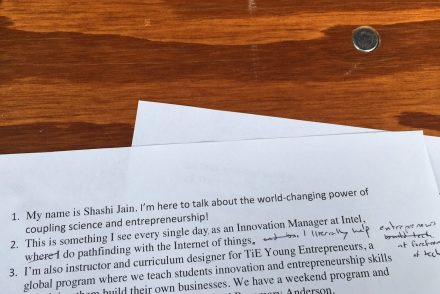The short answer is YES! TiE Young Entrepreneurs (TYE) is an invention, innovation, and entrepreneurship program that teaches high school students to turn their ideas into startups. Central to the process is to give the idea form, to push beyond words on a page into a prototype that encompasses everything learned by the team.
Motivation
Startups are a great way to explore new ideas and prove them out. The exist to find big problems to solve, for paying customers. Early-stage startups journey through three distinct phases:
- Problem-Solution Fit – Finding a “migraine problem” or one severe enough that people will pay to make it go away.
- Product-Market Fit – Developing a solution that solves the “migraine” problem in a unique, compelling way for your customers. Interviews will
- Scale – Building an operation that delivers the solution to as many customers as possible.
TYE focuses on the Problem-Solution Fit phase in the classroom sessions. Students will learn how to find a “migraine problem” by interviewing potential customers, asking open-ended and qualitative questions to define the problem space clearly. Once the problem is well-defined, students move on to rapid prototyping solutions and testing their fitness with potential customers in a more quantitative approach. So, to answer the original question in a more nuanced way- TYE teams need to develop prototypes that facilitate all stages of customer interviews.
Method
There are four TYE judging criteria:
- Business Model – Can you deliver a product/service with profit?
- Customer Validation – Have you spoken to customers about the problem, your solution, the business model, and user experience?
- Execution – Have you built your product or service and incorporated customer feedback?
- Teamwork – Have you distributed the work amongst your diverse team members?
To (partly) fulfill Execution criteria, all TYE teams are expected to build a representation of their idea. That may start as a mockup, drawings, or slides showing the look and feel of the proposed product or service. Teams must the refine the initial mockup or drawings after interviewing customers, identifying pain points, and testing hypotheses. Teams are expected to add features/functions into their prototype that solve the pain points, with desirable user experience. For Local competition, teams should have shown their prototype to customers and incorporated their feedback on functionality (does it solve the problem) at least once. At the Global competition, teams should have refined their prototype after two or more rounds of customer feedback, including business model (can it be built cost effectively) and user experience (is it desirable).
Shashi’s advice: The more iteration and refinement after customer interviews, the better the teams can expect to do in competition. A rule of thumb is “one round” is 25 customer interviews. For a team of 5, this is one interview per day, per founder, for one week.
This table summarizes how to refine different kinds of prototype for TYE Competitions.
| Initial (a few interviews) | Local Competition (1 Iteration) | Global Competition (2+ Iterations) | |
|---|---|---|---|
| App / SaaS | Drawings or Screenshots (paper, Canva, Powerpoint) | Basic App Mockup (Flinto, etc.) | Good: App mockup video demo Better: Advanced App Prototype (AppInventor) Best: Useable App (Testflight, Deployed) |
| AI | Generative AI to show application | Interactive | Good: Video AI demo Better: Unrefined usable AI demo Best: Refined, usable AI with tuning |
| Physical Product | Drawings or “Looks like” low-resolution prototype using crafted materials | Basic Functional prototype using 3D printing, laser cutting, sewing, etc. | Good: Video showing functional prototype Better: Refined functional prototype Best: Detailed, usable functional prototype |
| Service | Service menu or storyboard with user experience | Service prototype – all manually operated | Good: Video showing service Better: Basic Service partially functioning Best: Initial customer-ready service. |
Teams that lack a prototype or MVP at Globals will score poorly on the Execution and Customer Validation criteria, which minimizes chances to advance from Semi-Finals to Finals and/or for winning track prizes in those categories. Globals-bound teams that lack a prototype should invest time in creating one and refining with customers at least once.
Example
Team Melaknow from TYE Oregon won 2018 TYE Globals with an app that detects skin cancers. They spoke to 300 customers in total and delivered a functioning app with 98% accuracy at Globals. In their idea stage, they used hand-drawn screens of their app during their customer interviews. They learned that this app wasn’t a big problem for melanoma patients, so they pivoted to dermatologists. They showed a slide-based mockup to dermatologists, who rejected the app because their existing tools were superior. The dermatologists suggested general physicians could use this tool to prevent misdiagnosis and consequently bad referrals. General physicians, informed the team they were first to spot skin cancers and that they had no good tools- just a subjective test. The team incorporated this test into an AI and built an app incorporating several rounds of general physician feedback over four weeks. At Globals, team Melaknow handed a working app to the judging panel, running on their personal phones and tablets. Several physicians wrote letters of intent and testimonials for the team, because they needed the app. This level of commitment demonstrated that team Melaknow had achieved Product-Market fit.
Summary
- TYE teams must build a prototype to demonstrate they have a solution to a customer migraine problem, at minimum.
- More refinement of the prototype using customer feedback is needed in functionality (does it work), user experience (desirability), and business model (is it a differentiated, economically viable).
- The most competitive teams at Globals demonstrate multiple rounds of refinement and strong customer affinity for their solution, which is the definition of a minimum viable product.
Resources
Check here https://www.shashijain.co/rapid-prototyping for a list of tools curated by me to quickly create mockups and prototypes.
last edited: 12/1/2023






No Comments